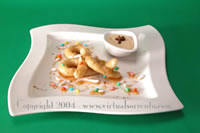The Greek origins of the culinary art of the Sorrentine Peninsule
by
(Translated by Marianna Mastro)
![]() t was about
three thousand years ago that a group of Greek origin landed on “Megaris”,
the legendary rock which overlooks the Parthenopean
Gulf and where is set the Castle dell’Ovo.
t was about
three thousand years ago that a group of Greek origin landed on “Megaris”,
the legendary rock which overlooks the Parthenopean
Gulf and where is set the Castle dell’Ovo.
Following this first settlement, afterwards the population moved to other areas of the Gulf of Naples and more precisely to Cuma, Capri, Ischia and Sorrento where they brought the wine and the olive cultivation.
Unfortunately, of the Greek’s alimentary customs we do not have many traces besides those of a “Greek wine” so defined in the diary of some foreign travellers who have visited our region up to the 18th century and also of some very ancient sweets made with honey which also recall to far away Aegean Islands. It appears acceptable to me that the adjective “Greek” was used to indicate the wines produced in Torre del Greco and in all the areas surrounding the Vesuvius. The Hellenic adjective was afterwards substituted by the blasphemer “Lacrima Christi” with which are still designated the wines produced with the vines imported from the island of Euboea.
During that age, the Peninsula was more green and fertile than today and the nourishment was still based on the picking of berries, tubers, roots and stems of mountain plants. Of course, not only of sweet acorns roasted or grounded, but also of pears, sorbs-apples, strawberry-trees, carobs, quince, lettuce, bitter chicory, big cardoon, mountain celery, a strong scented organ, thyme, and mushrooms.
In every house or hut there is a big grooved and a bit hollowed rock on which runs back and forth another smaller rock easily used to reduce in smaller pieces every type of grain and legume.
 The spelt flour was used for delicious dishes flavoured with pieces of
pig lard, or olive oil or sweetened with honey. It may derive from so
far away the appetizing local “zeppola di farina bollita” (a
fried boiled pasta) commonly called “zeppola del pezzente” (the
fried boiled pasta of the poor people), included in the traditional Christmas
confectionary of our region. The spelt is rare and precious and also low
cakes and buns were made from this flour and cooked under the ashes.
The spelt flour was used for delicious dishes flavoured with pieces of
pig lard, or olive oil or sweetened with honey. It may derive from so
far away the appetizing local “zeppola di farina bollita” (a
fried boiled pasta) commonly called “zeppola del pezzente” (the
fried boiled pasta of the poor people), included in the traditional Christmas
confectionary of our region. The spelt is rare and precious and also low
cakes and buns were made from this flour and cooked under the ashes.
Lamb and goat meat are common food in the occasions related to sacrifices and to the feasts dedicated to the gods, while to the goddess of the fertility is offered a special bun prepared on top with a fresh made goat or sheep cheese which with a bit of fantasy, but not too much, recalls the Sorrentine custom of the “giuncata”. The “giuncata” is a curdled, non salted milk put to drain in small reed baskets or on small mats which was then served on fern leaves and eaten until the beginning of the century in the Sorrentine Peninsula in occasion of the Feast of the Ascension- Day.
This tradition recalls also the small sweet ricotta cheese covered with honey, then substituted by the thick and tasty sour black cherry syrup and decorated with the same fruit, these were eaten in Sorrento in occasion of the Carnival and more precisely in occasion of the masquerade called “la guardia di Quaresima” (the guard of Lent).
